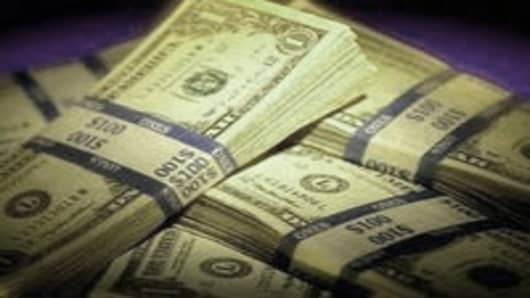The verdict appears to be in for the US dollar, and it's not looking good long-term.
A tepid domestic economic recovery—against faster growth in other parts of the world—likely will weigh against the greenback.
Indeed, commodity traders continue to bet against the dollar, inflating oil prices even as demand sagsand keeping gold—the ultimate inflation hedge—above $900 an ounce.
While investors expect the belief that the worst is over for the US economy will keep a floor beneath the dollar, the prognosis over the long haul remains bearish.
"Medium- to longer-term we certainly think the dollar is going to be weaker rather than stronger," said Giles Conway-Gordon, co-chief investment officer at Cogo Wolf Asset Management in San Francisco. "There are still problems for the US economy in terms of global competitiveness. One possible solution to that is going to be a weaker dollar."
Economic data released Thursday around the world underscored the hurdles the dollar will face.
In the US, retail sales took an unexpected drop that came despite the government's highly touted "Cash for Clunkers" automobile trade-in program, while jobless claims, which had been seen as ebbing, instead grew last week.
At the same time, both Germany and France proclaimed an end to their respective recessionsas gross domestic product rose 0.3 percent in both nations for the second quarter.
Analysts at Bank of America-Merrill Lynch cited "an improved macro backdrop and the reduced likelihood of a risk shock" in changing their dollar forecast against the euro from $1.38 to $1.50 by year's end.
BofA-Merrill recently advised clients to go to mega-cap companies with a stock market value of at least $20 billion as well as multi-nationals, which the firm said is backed by a belief in a weakening dollar.
The dollar faces other problems as well.
Even as it handles a massive debtload, the Federal Reserve remains under pressure to hold interest rates low in order to keep the flow of cash intact. On cue, the Fed said Tuesday following its two-day meeting that it was keeping the target rate near zeroand remains cautious about the economy.
While the Fed broke recent tradition by not warning of weakening conditions, it only said the economy was stabilizing.
"The main problem is the consumer," Conway-Gordon said. "We think the consumer is going to be deleveraging for quite some time...We can't see the Fed raising rates until well into next year."
Analysts at Brown Brothers Harriman echoed that assessment, predicting in analysis released before the Fed decision "downside risk for the dollar if the FOMC statement dampens speculation of a Fed hike in Q1 next year, or if the Fed surprises the market by extending its Treasury purchases, as the $300 billion commitment will be complete next month." The Fed did say it was extending the program, but only by a month, through October.
Finally, there are worries about whether foreign investors will lose their confidence in the US currency if the economic recovery doesn't accelerate.
"If they have second thoughts about the quality of this currency, then the dollar is bound to weaken," Deutsche Bank Chief Economist Norbert Walter told CNBC in an interview Thursday. That means higher long-term interest rates for a country where government debt is approaching 100 percent of gross domestic product.
To be sure, not all the signs are bearish for the dollar, and some analysts believe any drops in the greenback will not be precipitous.
The narrowing trade gap means less demand for foreign currency, while economists also are getting less worried about inflation threats.
"More than likely we could drift lower in terms of emerging-markets currencies," said Tom Higgins, chief economist at Payden & Rygel in Los Angeles. "The fundamentals I see in Europe and the UK and even Japan don't seem to warrant a much weaker dollar and a much stronger euro, pound or yen. You're more likely to see the dollar drift lower modestly but not significantly lower, although everybody seems to think the dollar is on the verge of collapse."
Higgins predicted a "fat chance" of the Fed inflating the economy out of recession and said a reasonable level — 3 percent or so — would be good for a recovery.
"Dr. Doom" Marc Faber, meanwhile, is predicting a period of stronger dollar growththat will pressure the US stock market. The author of the "Gloom, Doom and Boom Report" cited likely improvements in emerging and established markets as factors that will boost currency levels.
Another positive sign was the dollar actually strengthening last Friday when the monthly unemployment report saw a slight decline in the jobless rate. Positive economic data had been previously leading to dollar selloffs.
"We think that should help. It's kind of reversing some of the trends," said Brad Sorensen, sector analyst at Charles Schwab. "We think the dollar will tend to strengthen a little bit, not substantially, but stabilize and strengthen through the course of the year."
A stronger dollar, though, seems at best to be a contrarian view at this point.
"The big surprise could be the dollar hangs in there and possibly even strengthens, because everybody believes it's going to weaken," Higgins said. "At this point if I'm talking near term for the next six months, I'd be more inclined towards a weaker dollar, but just not dramatic."



